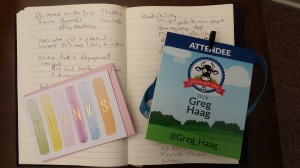 WordCamp – the name conjures up an idyllic scene in the deep woods fighting off mosquitoes, making smores, and discussing the attributes and origins of words. Although Idyllic (in beautiful downtown Milwaukee), WordCamp is an event where people gather to learn about WordPress, the open source platform that 20% of the world’s websites run on.
WordCamp – the name conjures up an idyllic scene in the deep woods fighting off mosquitoes, making smores, and discussing the attributes and origins of words. Although Idyllic (in beautiful downtown Milwaukee), WordCamp is an event where people gather to learn about WordPress, the open source platform that 20% of the world’s websites run on.
Archives for July 2014
What I Did at WordCamp Milwaukee 2014
July 29, 2014 by Leave a Comment
You don’t just have to be a web developer to get something out of it. Though I’d say two-thirds of everyone attending works in web dev, there are tracks for marketing, blogging and content, design, business, and user and general information. Basically, something for everyone, from the expert to the person just starting out.
WordCamp is a great community more than anything else. It’s a great place to reconnect with friends, meet new people, learn about WordPress, marketing, blogging and tons more, and give back to the community. And, that’s exactly what I did at WordCamp Milwaukee 2014.
Reconnect with friends: One of the first things I did, even before the event, was reconnect with people I met last year to confirm they were attending. Some were, some weren’t. On the morning of the first day I tweeted out to Tom Kepler, a web developer from the Chicago area who I met last year, to find out where he was. Once there, we had a great time catching up and deepening our friendship.
Meet new people: Throughout the day people would introduce themselves. I would too. You’d get to know each other quickly; “I’m a developer at so and so company,” or “I’m a freelance designer.” I introduced myself as a writer or partner at Glass Fish Creative, a business I’m just starting designed to help small businesses and entrepreneurs with their marketing. Many people shared their own stories of going out on their own. It was great to find out what everyone’s take was on freelancing and working for someone else.
There was also a great after-party down the street at the Hilton City Center. It gave us an opportunity to mingle with others we hadn’t had a chance to meet during the day.
Learn about WordPress: Session after session was filled with valuable information. Who knew non-profits could get free website hosting or that there are ways to make using public Wi-Fi safer?
Learning didn’t just happen during sessions; people were sharing ideas in between sessions, during lunch, in the Happiness Bar area (no drinking was involved, it was a room where experts were available to answer your questions about WordPress).
Give back to the community: During one session on non-profits, the speaker commented about a hackathon that took place the day before for a local group called My Sista’s KeepHer that helps young women find their identify through writing workshops. He mentioned that they needed help with content and blog posts. That was right up my alley, so I ended up writing a blog post, some other content, and fixing some SEO issues. In one weekend, they went from not having a website, to having one where they can spread the word and take donations. It felt great to give back and be a small part of that.
As I was leaving Sunday night, I walked out with one of the speakers I saw earlier in the day and told him how much I enjoyed his session. He asked what I was going to implement right away and I told him my brain was a little foggy and couldn’t think of anything right then. He mentioned that he had trouble focusing during the last two sessions of the day as well. That’s WordCamp, there’s so much to take in, in such a short amount of time that it’ll take a while to process it all, but what a great way to spend a weekend.
Are there any events that you’ve planned as part of your summer? How will you, or how did you, spend your time?
6 Ways to Recharge Your Batteries
July 22, 2014 by Leave a Comment
 When life is draining energy from you, how do you get it back? When you need to be at your best you can’t afford to let up, but sometimes that’s exactly what you need to do.
When life is draining energy from you, how do you get it back? When you need to be at your best you can’t afford to let up, but sometimes that’s exactly what you need to do.
We’ve all had those days where, as soon as one item gets checked off the to-do list another pops up. You can get mentally and physically wiped out. How do you keep going when you feel like you’re about to keel over?
Here are six ways to recharge your batteries when they’re nearing empty.
1) Take a nap. A good 20-30 minute nap can do wonders. In many parts of the world, and some forward thinking companies here, this is built into the work day.
2) Go for a walk. It’s always a good idea to get some fresh air. It gets the blood circulating and you can focus on something else for a while. You’ll come back ready tackle your next challenge.
3) Read. Pick up a book and fill your head with other people’s stories, ideas, and motivational words. It could just spur some new ideas of your own.
4) Listen to music. What music makes you want to rock out to some air drums or air guitar? Put that music on. Let that music fuel your next creative burst.
5) Watch a TED talk. These insightful 20 minute nuggets of inspiration will pump you up. Be careful to watch just one. One can quickly turn into three very easily.
6) Grab a drink, or bite to eat, with someone who inspires you. There’s nothing like connecting with someone face-to-face who makes you think differently and helps elevate your game to the next level. Plan these get together as part of your week. You’ll be glad you did.
Have any of these worked for you? What else have you done to recharge your batteries? Next time you feel you’re about to nod off, find an activity to power-up and rock it the rest of the day!
3 Ways to Get Ready for a Major League Tryout (or for a Major Life Change)
July 15, 2014 by Leave a Comment
 When I was in my early teens, my dream was to play Major League Baseball. I used to eat, sleep, and dream baseball; I still have dreams where I’m playing. I thought I was pretty good and if I had kept up with it who knows what might have happened. In my late teens, music took over my life and baseball took a backseat.
When I was in my early teens, my dream was to play Major League Baseball. I used to eat, sleep, and dream baseball; I still have dreams where I’m playing. I thought I was pretty good and if I had kept up with it who knows what might have happened. In my late teens, music took over my life and baseball took a backseat.When Robin Yount retired in February 1994, it marked the end of an era; the last piece of the team that I grew up with and loved was really gone. Who was going to replace Robin Yount? I felt that center field should be taken over by someone local, someone who understood what taking over that position meant, and I was the perfect person to do it. So, I decided I was going to get myself in shape and try out at County Stadium and take over Robin’s spot in center field.
In order to accomplish that goal I knew I needed to get myself ready physically, mentally, and emotionally. But, I knew I didn’t have much time to get ready since the Brewers had tryouts every July. That only gave me five months to get ready.
Here are the three ways I got myself ready for a Major League tryout:
First, I needed to get myself in shape physically. I started running. The first time I went out, I was out of breath after three blocks. It was kind of shocking since I had considered myself an athlete. After going out on daily runs, it didn’t take long until I was able to run a couple of miles no problem.
The other part of my game I needed to work on since I hadn’t played baseball in 10 years was to go to the batting cage. I played softball a couple of times a week, but hitting a baseball is completely different. I was going regularly to the batting cage to hone my skills. I needed to become a hitter again.
The second part was to get myself mentally prepared. I had to get into a baseball mindset. I went over scenarios in my head. I visualized games where I had played well. I also re-read Charlie Lau’s The Art of Hitting .300. It was like my bible growing up, and anyone who wants to be a great hitter should read it.
The final piece was to get myself ready emotionally. I knew it was a long shot to make the team. I hadn’t played consistently for about 10 years. There were going to be players there that were at the top of their game. I decided that above all else, I was going to have fun with the tryout.
As spring rolled into summer I was getting ready. I saw a flyer at the batting cage announcing a tryout with the Philadelphia Phillies at Nathan Hale High School in West Allis at the end of June; just a month before the Brewers tryout. I figured this was a great way to gauge where I was before I tried out for the Brewers and see what I needed to work on.
When I showed up the morning of the tryout, there were about 90 players gathered; a lot of them teenagers. I could see they were nervous as we lined up to register. This was probably the biggest thing in their lives up until that moment. Since I knew I was a long shot I started making jokes and having fun. I wasn’t nervous at all.
The tryout started well. The first thing the scouts did was time us running. I was one of the 10 fastest guys there. I saw scouts looking at me and comparing notes. Major league scouts were talking about me! Things were looking up.
Next, I went to the outfield and took some fly balls. I started joking around some more. Channel 4 had a reporter and cameraman there. They saw how I was making everyone laugh. They asked me for an interview which I was happy to do.
It was my turn and I took some fly balls in right field. My arm was hurting but I didn’t want to hold myself out of this part of the try out, but in hindsight it wasn’t the best move. I was supposed to catch the ball and throw it to third base but when I caught the ball I quickly bounced it into second base and it slowly rolled to third. The next was barely better, at least it bounced around short.
I went in to hit. It was near the end of the day and there weren’t any catchers and the pitcher wasn’t throwing strikes but it didn’t matter, I was swinging anyway. I got wood on a few of them that I popped up in the infield, but no solid hits. What started out so well, ended quietly. I walked to the parking lot, without any scouts running after me, and saw one of my friends waiting for me. We talked about the entire experience. I had a Major League tryout!
Channel 4 did a spot on the tryout for the 6:00 news cast. It was really cool to see myself on TV taking fly balls and being interviewed. I had fun like I had set out to do and I had made a bunch of kids, who were nervous as heck, relax a little. I felt that I had done what I set out to do.
Since I knew I wasn’t going to improve my game much more in the next few weeks, I decided to skip the tryout with the Brewers; although I should have done it just to say I walked on the same field as so many great players.
If there’s something you’re pursuing make sure you are prepared physically, mentally, and emotionally for the experience. If things go your way, you’ll be ready to perform at a high level, and if things don’t go as planned at least you can take away something positive from the experience to help you grow as a person. You may even make a few people laugh in the process and end up on TV.
You Ain’t Gettin’ No Co-signer
July 8, 2014 by Leave a Comment
 When I was looking to buy my first car (lease actually), I learned a valuable lesson about figuring things out on my own. After putting down $750 and setting a date to take delivery on a new Sentra with the salesman, the owner of the dealership called me and told me I didn’t have enough credit and that I would either need to give them more money up front or get a co-signer.
When I was looking to buy my first car (lease actually), I learned a valuable lesson about figuring things out on my own. After putting down $750 and setting a date to take delivery on a new Sentra with the salesman, the owner of the dealership called me and told me I didn’t have enough credit and that I would either need to give them more money up front or get a co-signer.I told my dad about the situation. He said to me, “You ain’t gettin’ no co-signer.” He asked if I had any extra money. I told him I didn’t. He said it didn’t sound like I was getting that car and that I had better look at other options.
I wasn’t sure what I was going to do at that point. After going through the hassle of getting a canceled check to get my money back from the dealer, I was back at square one.
I was likely to run into the same thing at other dealerships. I had to figure things out for myself. How was I going to get a car with my credit history at an affordable monthly payment? I looked over the scenarios I had to work with: 1) I could buy a used car with the $750 I had. This made me feel uneasy since I had seen other people buy used cars that didn’t last long. 2) I could save up for a larger down payment. That would take months and I only had a few weeks time before the car I was borrowing from my mom would be traded-in. 3) Find an alternate way to get to work. This wouldn’t work. I didn’t live on a bus line and none of my co-workers lived near me.
I remembered that Ford had sent me a postcard about buying a car and getting a discount for being a recent college graduate. I wasn’t sure what recent meant since I had graduated a year and a half earlier, but it was worth a shot. I wondered how they’d sell me a car when the other dealer wouldn’t let me lease one.
I went to Ford and was able to buy a new Ford Escort without having to get a co-signer and without having to put anything more than $750 into my initial payment.
Had my dad handed over the additional money, or co-signed for my car, I wouldn’t have had to figure things out on my own. It also wouldn’t have given me the same sense of accomplishment. It wouldn’t have taught me the lesson of doing things for myself. I wasn’t looking to buy a car, but buying a car instead of leasing it, got me the transportation I needed.
I’ve learned not to rely on others to help me. Not that they won’t help, but I don’t expect it. If you want something, put the effort in to accomplish it yourself. It’ll feel that much more satisfying when you get it on your own.
Is there anything you’re working on, or a situation that you’ve run into, that seems impossible to overcome? How will you respond when you have to figure things out for yourself? How creative can you get? The impossible might just be possible. It’s up to you.
How to Keep Your Self-Talk Positive
July 1, 2014 by 4 Comments
 Science has shown that we have anywhere from 30,000 to 70,000 thoughts a day, which means we are bombarded with self-talk every minute we’re awake. How do we allow ourselves to remain positive when there’s so much coming at us?
Science has shown that we have anywhere from 30,000 to 70,000 thoughts a day, which means we are bombarded with self-talk every minute we’re awake. How do we allow ourselves to remain positive when there’s so much coming at us?It isn’t easy, but in order for us to give our best we need to remain positive.
Here are four tips I use to keep my self-talk positive:
1) Look at your strengths. You need to know what your strengths are. If you don’t know what they are, write them down. Be honest. What have you accomplished successfully in the past? What made you successful? You still posses the talent to be able to do it again. When you know your strengths it also builds confidence, and confidence is a powerful attribute to have.
2) Look at your “secret sauce.” What makes you unique? What makes you stand out? Do you have a skill or talent that not many people have? Look at your intangibles. More often than not, those are the things that will set you apart from the rest of the crowd. When you know what your “secret sauce” is, flaunt it every opportunity you have.
3) Look at the long-term goals. Thomas Edison found 1,000 ways not to make the incandescent light bulb. How many times do we give up when things don’t go our way immediately? Last year, Nicki Minaj gave a contestant great advice after they got rejected during an audition on American Idol. Minaj told the discouraged contestant, “Do you know how many times we’ve been told no? (referring to the judges}. We heard 1,000 no’s before we got a yes. You leave here and hold your head up. If you want it bad enough you keep working until you get to yes.”
4) Focus on pleasing yourself. This isn’t being selfish. It’s beneficial for everyone who comes in contact with you. Look at what makes you happy. If I’m trying to please someone else, or live up to their expectation of who I am, I can’t be the best version of myself I can be. It doesn’t matter if no one else gets you, if you get you, others eventually will. Then they’ll wonder how you do it.
Make sure the conversation with yourself is positive and reinforcing. We can’t completely avoid negative self-talk. It’s bound to creep in, but we can keep it to a minimum if we try. What you say to yourself (and think about yourself) determines how you will succeed. What is your self-talk?
Follow Me!